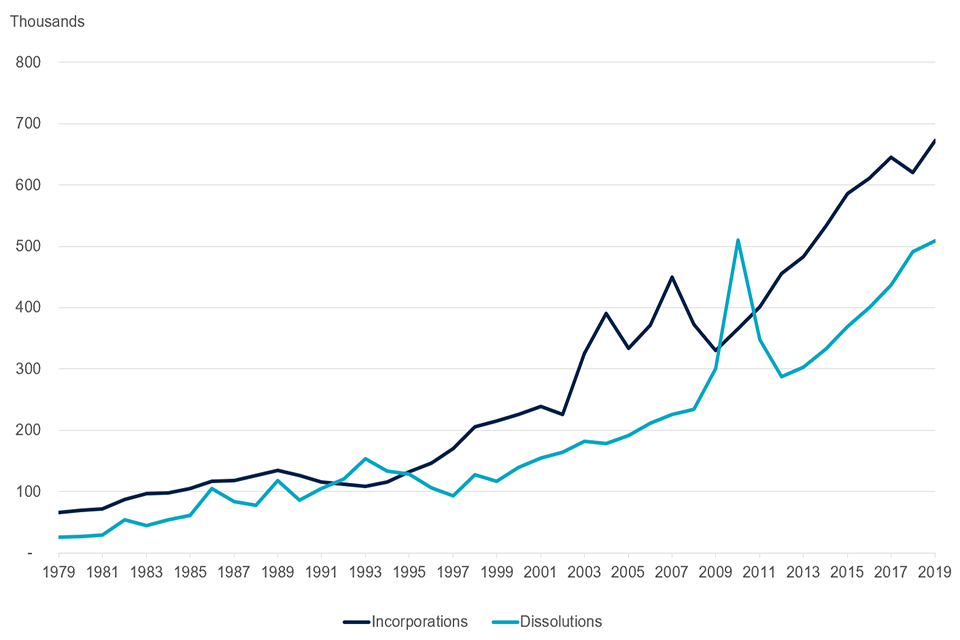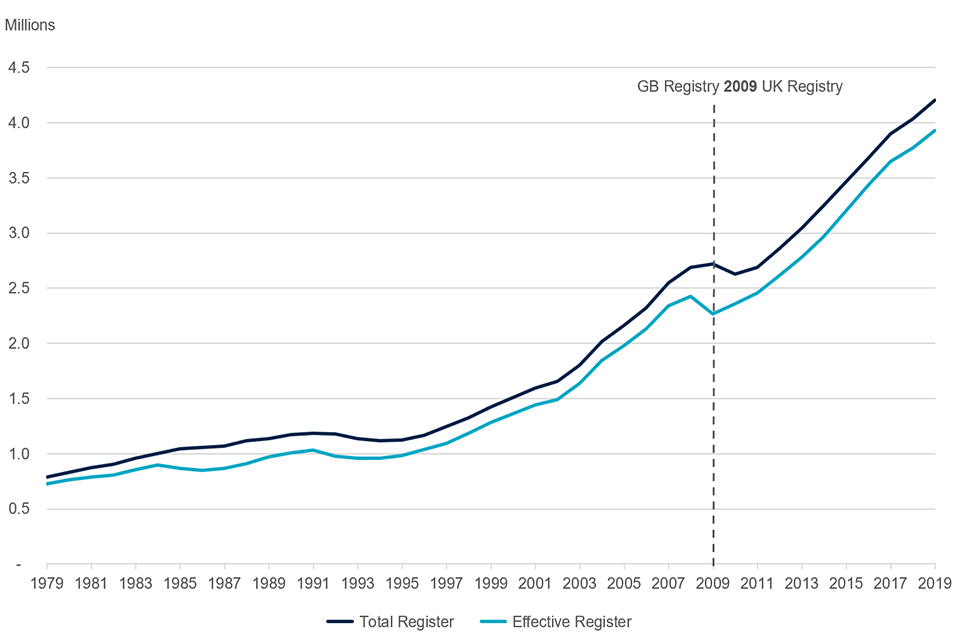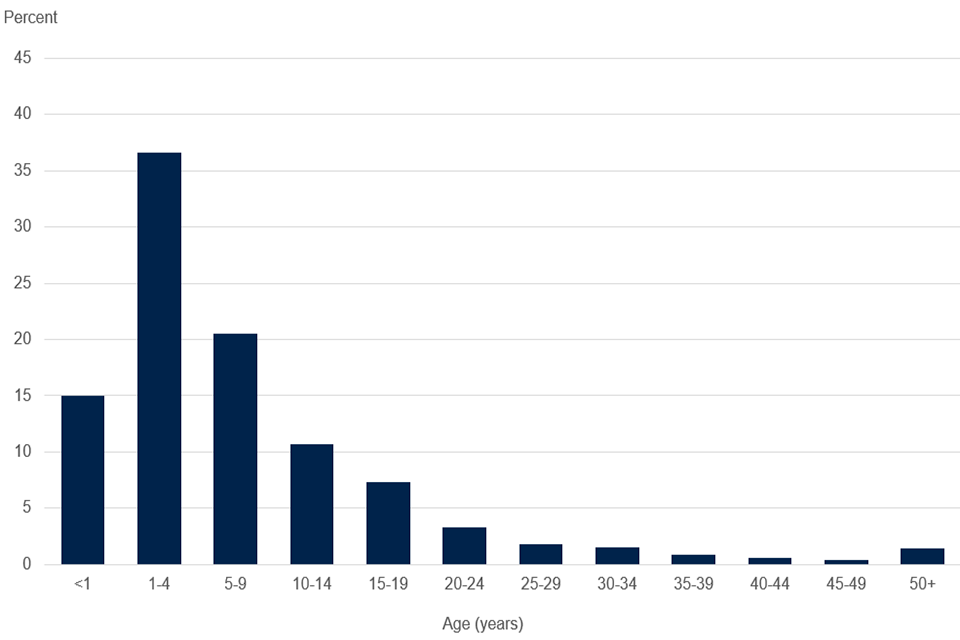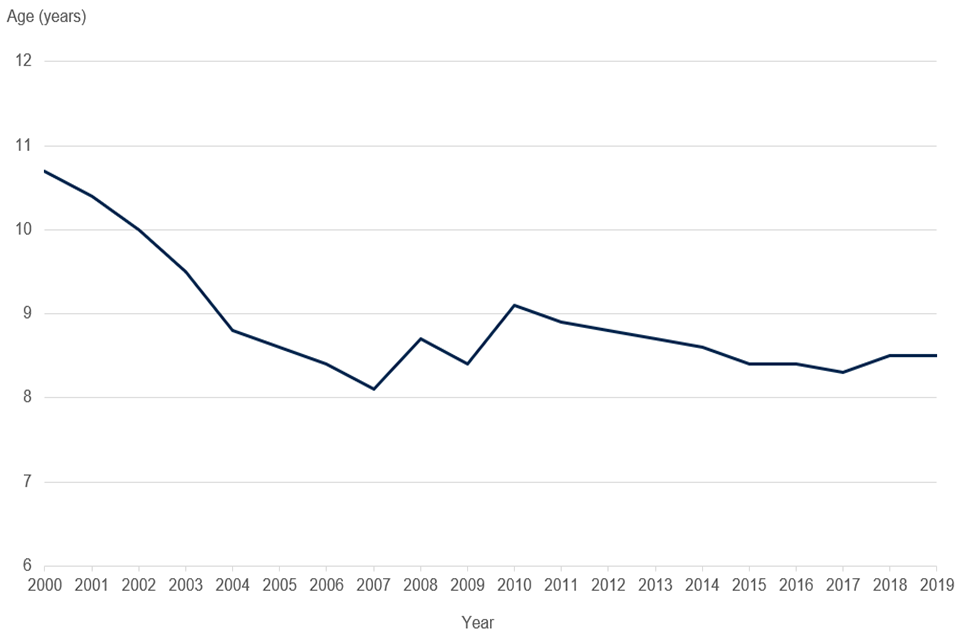Companies register activities: 2018 to 2019
Updated 1 August 2019
Revision notice
Due to a processing issue, several figures in the Key points, Section 5 (Types of corporate body on the register) and Section 6 (Overseas corporate bodies with a physical presence in the UK) have been revised on 1 August 2019.
1. Introduction
This release provides information about the population of companies and corporate bodies in the UK. Companies and corporate bodies are specific legal forms of business that are registered at Companies House. Companies form a subset of corporate bodies and are formed under the Companies Act 2006. Companies and corporate bodies are registered at Companies House regardless of whether they go on to trade actively. Full definitions of both companies covered by the Companies Act 2006 and corporate bodies are provided in the separate Companies House official statistics: definitions to accompany statistical releases document. This document also explains the incorporation, dissolution and restoration processes.
This release complements the quarterly Incorporated Companies in the UK release by providing information on both companies to which the Companies Act 2006 relates, and on wider corporate body types. Sections 2 to 4 of the release focus specifically on companies, while sections 5 and 6 cover all corporate body types. Some figures in this release may differ to those provided in the quarterly Incorporated Companies in the UK publications due to the timing of the analysis. Analyses for the figures in this release are undertaken later in the year, allowing more information to be processed and added to the register.
The statistics in this release include the total number of incorporated companies, newly incorporated companies, and the number of companies that were dissolved. The release focusses on the headline messages for the UK: figures for the constituent countries are contained in the supplementary tables that accompany the release.
Key points
- The total register size at the end of March 2019 was 4,202,044, an increase of 4.2% when compared with the end of March 2018.
- Between 2017 to 2018 and 2018 to 2019, register growth has slowed (4.2%) when compared with the average growth of the previous 5 years (5.8%).
- There were 672,890 company incorporations in 2018 to 2019. This is an increase of 8.5% when compared with 2017 to 2018. This is the highest number of incorporations since 2009 to 2010.
- In 2018 to 2019, there were 508,865 dissolutions in the UK, a year on year increase of 3.7%. This is the largest number of dissolutions since 2009 to 2010.
- The average age of a company on the total register at the end of March 2019 was 8.5 years. Despite fluctuations in recent years, the average age of a company has gradually declined from 10.7 years since 2000.
- Since 2004, private limited companies have consistently accounted for over 96% of all corporate body types. During this time, the three corporate bodies accounting for the highest proportion of all corporate bodies remained unchanged. Private limited companies, limited liability partnerships (LLPs) and limited partnerships have consistently accounted for over 98% of all corporate body types.
2. Incorporated companies
The total register size – including those in the process of dissolution and liquidation (275,670) – at the end of March 2019 was 4,202,044. This is an increase of 4.2% when compared with the end of March 2018. The effective register, which does not include those in the process of dissolution and liquidation, at the end of March 2019 was 3,926,374. The total register for England and Wales increased by 4.2%, Scotland increased by 4.1% and Northern Ireland increased by 6.4%.
Figure 1: The number of companies by region at the end of March 2019

Figure 1 showing the number of companies by region at the end of March 2019. [Source: Companies register activities, 2018 to 2019, Companies House.]
During 2018 to 2019, there were 672,890 company incorporations, a year on year increase of 8.5%. Incorporations increased by 49,170 (8.4%) in England and Wales whilst Scotland increased by 2,420 (7.9%). Northern Ireland saw the highest percentage increase of 14.3%, an increase of 1,015 incorporations.
In the same year, there were 508,865 dissolutions, an increase of 3.7% compared with 2017 to 2018. The highest rate of increase in dissolutions were found in Northern Ireland (12.1%), followed by Scotland (7.4%) and England and Wales (3.4%).
Despite fluctuations, the number of incorporations and dissolutions have increased overall over time. There are 606,390 more incorporations in 2018 to 2019 compared with the number of incorporations in 1979, whilst there are 483,193 more dissolutions over the same period.
Although the size of the register has continued to increase at a steady rate, the number of incorporations and dissolutions were noticeably higher during 2018 to 2019.
Chart 1: UK incorporations and dissolutions from 1979 to 2019

Chart 1 showing total yearly UK incorporations and dissolutions from 1979 to 2019. [Source: Companies register activities, 2018 to 2019, Companies House.]
A full breakdown of figures for England and Wales, Scotland, Northern Ireland and the UK as a whole is provided in Table A1 in the Excel workbook that accompanies this release. Figures are provided for the years 2012 to 2013 through to 2018 to 2019. Separate figures for private companies and public limited companies are provided in Tables A2 and A3, respectively.
3. The growth in the register size over time
Between 1979 and 2019, the total register has increased by 3.4 million companies whilst the effective register has increased by 3.2 million companies. [footnote 1], [footnote 2].
During this time, the total register has seen 36 annual increases, whilst the effective register has increased 34 times over the same period. The most recent declines in the Great Britain effective register occurred in 2008 to 2009, with a decrease of 157,700 companies. The UK total register declined a year later in 2009 to 2010, with a decrease of 88,300 companies.
In the late 2000s, it was anticipated that the register size would increase due to the introduction of Northern Ireland companies to the UK register. However, this may have been offset by the global financial crisis at a similar period leading to a slight decrease in the register size overall.
During the period 2009 to 2010 there were also several significant changes to the register:
- the Northern Ireland register was included to create a UK register
- there was a change in the administrative system that forms the register
- there was a purge on the register to remove defunct companies that had spent an extended period in the process of dissolution or liquidation
- legislative changes were introduced under the Companies Act 2006, which reduced the time taken to dissolve companies and remove them from the register
These changes in combination are likely to have contributed to a sharp increase in the number of dissolutions between 2009 and 2010. This may in turn have had an impact on the sizes of the total and effective registers overall.
Since 2010 to 2011, both registers have continued to increase in size in a steady fashion, albeit at a slower rate in recent years.
Between 2012 to 2013 and 2017 to 2018, the average growth rate for the total and effective registers was 5.7% and 6.0%, respectively. During 2018 to 2019, the growth rates have slowed to 4.2% and 4.1%, respectively. Both growth rates in 2018 to 2019 are lower than the average growth seen over the previous 5 years.
Chart 2: UK total and effective register sizes from 1979 to 2019

Chart 2 showing yearly UK total and effective register sizes from 1979 to 2019. [Source: Companies register activities, 2018 to 2019, Companies House.]
Table A8, in the workbook that accompanies this publication, shows the total and effective register sizes from 1939 to 2018-19, as well as the annual number of incorporations, dissolutions, liquidations and insolvencies.
4. Age of companies on the register
The average age of UK companies on the total register in 2018 to 2019 was 8.5 years, consistent with 2017 to 2018. Within both the total and effective registers for 2018 to 2019, over half of the companies were aged under five years (51.6% for the total register and 51.5% for the effective register). Over two-thirds (72.1% for the total register and 72.0% for the effective register) were under 10 years. Less than one in ten companies were aged over 20 years on both the total and effective registers.
Chart 3: Age profile of companies on the total UK register for 2019

Chart 3 showing the age profile of companies on the total UK register for 2019. [Source: Companies register activities, 2018 to 2019, Companies House.]
Historically, the average age of companies has always been relatively young, but it has gradually declined from 10.7 years in 2000 to 2001 to 8.5 years in 2018 to 2019. Between 2008 to 2009 and 2010 to 2011 the average age of companies fluctuated, corresponding with fluctuations in the numbers of incorporations and dissolutions, and declines in the overall register size.
Since 2000 to 2001, the steady decline in the average age of companies could be due to the general increasing trend we have seen in the number of incorporations and dissolutions. It is likely that the increasing number of incorporations has led to a greater number of younger companies on the register, which has served to lower the average age of companies overall. The average age of dissolved and closed companies has declined from 5.7 years in 2012 to 2013 to 5.0 years in 2018 to 2019.
Chart 4: Average age of companies on the total UK register from 2000 to 2019

Chart 4 showing the average age of companies on the total UK register from 2000 to 2019. [Source: Companies register activities, 2018 to 2019, Companies House.]
Table A5, in the workbook that accompanies this release, shows the age profile of companies on the total and effective registers at 31 March 2019, as well as those in liquidation or the course of dissolution. The table also shows the average age of companies from 2000-01 to 2018-19. Table A11 shows the average age of dissolved and closed companies from 2012-13 to 2018-19, while Table C3 shows average ages at closure and dissolution across all corporate body types.
5. Types of corporate body on the register
There are over 23 types of corporate body held on the register. These include a number of corporate body types in addition to those companies covered by the Companies Act 2006. Each corporate body type has its own requirements to provide information to Companies House, as outlined in various pieces of legislation and royal acts. Further information on the different company types can be found in the Companies House guidance.
Since 2004, private limited companies have consistently accounted for over 96% of all corporate body types. During this time, the three corporate bodies accounting for the highest proportion of all corporate bodies remained unchanged, being private limited companies, limited liability partnerships (LLPs) and limited partnerships. These three corporate body types consistently accounted for over 98% of all corporate body types.
Table 1: Breakdown of corporate body types on the total UK register for 2018 to 2019
| Corporate body type | Number | Percentage of all corporate bodies |
|---|---|---|
| *Private Limited | 4,040,779 | 92.8 |
| *Private Limited by Guarantee/No Share Capital | 108,483 | 2.5 |
| Limited Liability Partnership | 52,429 | 1.2 |
| Limited Partnership | 51,761 | 1.2 |
| *Private Limited by Guarantee/No Share Capital/(Use of Limited Exemption) | 41,923 | 1.0 |
| Charitable Incorporated Organisation | 20,863 | 0.5 |
| Overseas Company | 12,236 | 0.3 |
| Industrial and Provident Society | 9,543 | 0.2 |
| *Public Limited Company | 6,529 | 0.1 |
| Other corporate body types | 9,028 | 0.2 |
| Total of corporate body types | 4,353,574 | 100.0 |
Source: Companies register activities for 2018 to 2019, Companies House.
Although the composition of the register overall has remained stable, there have been some minor fluctuations within the individual company types:
- Charitable Incorporated Organisations (CIOs) were introduced in late 2017. The Charity Commission allowed charitable companies to convert to CIOs. This is an incorporated structure designed for charities and needs to be registered with the Charity Commission. For the financial year of 2018-19, there were 16,999 CIOs in England, Wales and Northern Ireland (0.4% of all corporate bodies) and 3,864 Scottish CIOs (0.1% of all corporate bodies).
- Limited liability partnerships (LLPs) were introduced in 2001. They gradually increased in number to make up 1.8% of the register in the years 2012-2014. The proportion of LLPs has since gradually declined, and they now account for 1.2% of the register.
- Limited partnerships have grown from 0.5% of the register at the end of 2004 to 1.2% at the end of March 2019. This has been primarily due to large increases in the numbers of limited partnerships in Scotland between 2012 and 2013 and they continue to make up a large share of limited partnerships on the register.
- Public limited companies have been declining in number since 2008. They now make up only 0.1% of the register overall.
Although these changes are small, they show the subtle ways in which the composition of the register is changing outside of private limited companies.
Table C1, in the workbook that accompanies this publication, displays numbers and percentages of all corporate body types on the register from 2004 to 2019. Further information on public limited companies, limited partnerships and limited liability partnerships is available in tables A3, B2 and B4, respectively.
6. Overseas corporate bodies with a physical presence in the UK
At the end of March 2019, there were 11,773 overseas corporate bodies on the total register. Overseas corporate bodies are incorporated outside of the UK but have a physical presence in the UK (such as a place of business or branch) through which they carry out their business. Since 2013-14, the number of overseas corporate bodies on the total register has increased by 1,355.
At the end of March 2019, the largest share of overseas corporate bodies on the register originated in the USA. This accounted for 2,552 (21.7%) of all overseas companies. The Republic of Ireland, the second highest originating country, accounted for 987 (8.4%). The top 10 countries incorporating corporate bodies in the UK in 2018-19 are consistent with those of the previous year. These countries accounted for 63.1% of all overseas corporate bodies on the total register at the end of March 2019.
Figure 2: Top 10 originating countries for overseas corporate bodies, 31 March 2019

Figure 2 showing the top 10 originating countries for overseas corporate bodies on 31 March 2019. [Source: Companies register activities, 2018 to 2019, Companies House.]
There were 738 new incorporations for overseas corporate bodies in 2018 to 2019. Of these, 98 (13.3%) originated in the USA, 96 (13.0%) in the Channel Islands and 70 (9.5%) in the Republic of Ireland. These three countries have consistently had the highest numbers of new incorporations since 2013 to 2014.
Table 2: Registrations of corporate bodies incorporated outside the UK in 2018 to 2019 for the top 10 originating countries
| Country of incorporation | New incorporations | Percentage of all incorporations |
|---|---|---|
| USA | 98 | 13.3 |
| Channel Islands | 96 | 13.0 |
| Republic of Ireland | 70 | 9.5 |
| Germany | 47 | 6.4 |
| Netherlands | 34 | 4.6 |
| Virgin Islands (includes 1 US Virgin Islands) | 31 | 4.2 |
| Isle of Man | 21 | 2.8 |
| France | 21 | 2.8 |
| Australia | 21 | 2.8 |
| Italy | 18 | 2.4 |
| Total | 457 | 61.9 |
Source: Companies register activities 2018 to 2019, Companies House.
Full figures on registrations of corporate bodies incorporated outside the UK from 2013-14 to 2018-19, as well as numbers on the register at 31 March 2019, are provided in table B1.
7. Other statistics in this release
A range of other statistics are included in the tables that accompany this release, including:
- analysis of companies on the register by period of incorporation
- removals of companies from the register
- other corporate bodies administered at Companies House, including limited partnerships and limited liability partnerships
A range of management information tables are due to be published later in the summer, providing information on:
- civil penalties for late filing of annual accounts
- disqualification orders notified to the Secretary of State in the UK
- prosecutions by the department under the Companies Act 2006
- number of documents filed at Companies House
- annual accounts registered at Companies House by accounts type
8. Background notes
This section provides a range of information designed to provide the user with more information about the statistics.
Definitions
A separate document is available providing definitions for the main terms used in Companies House official statistics publications.
Quality
Information relating to the quality of the statistics is provided in a separate quality document. This document provides information on the quality of Companies House’s official statistics, to enable users to judge whether or not the data are of sufficient quality for their intended use. The information is structured in terms of the quality dimensions of the European Statistical System. The document also provides information on how these statistics relate to selected other business statistics.
Coverage
This release provides information on the size of the company population and the changes that have occurred within the year. The release includes statistics for the UK, England and Wales, Northern Ireland, and Scotland. The statistics cover companies and corporate bodies, both of which are specific legal forms of businesses that are registered at Companies House. They do not include information on sole proprietorship businesses, partnerships, and charities.
Use and users
Companies House statistics are used extensively by government, the public, public bodies and businesses. For example, they’re used by:
- government in understanding the likely impact of policy changes and monitoring the impact of economic changes on companies
- businesses in understanding their market share and planning marketing strategies
- banks in developing an understanding of their customer base
- foreign firms in making UK location decisions
- academics to inform research into businesses at local and national level
- a range of public bodies in decision making and evaluating business-related policies
Revisions to these statistics
Revisions to these statistics will be mainly due to changes in methodologies and source data. The statistics are derived from administrative data, and changes to the underlying methods will cause revisions. These include changes in statistical methods, definitions, classifications, and geographic coverage.
Although Companies House has robust procedures in place to minimise errors in the methods used to create these statistics, errors may occasionally occur. If errors are found after the publication, their impact will be assessed. If the changes are significant, a corrigendum will be issued as soon as possible. Minor corrections will be included in the next planned release.
Any misleading or incorrect figures will be amended and a footnote added to indicate that the figures have been corrected. The nature and reason for the correction will be explained.
Date of next release
Statistics for the 12 months to March 2020 will be published in summer 2020. The publication date will be announced on our release calendar.
-
Statistics for 1979 to 2008 are for Great Britain. In October 2009, the Northern Ireland register merged with the register for Great Britain to create a UK register. Figures from 2009 to 2010 onwards are for the UK as a whole. ↩
-
Figures for 1979 to 1986 are for the calendar year 1 January to 31 December. Those for 1986-87 to 2016-17 are for the financial year 1 April to 31 March. ↩
